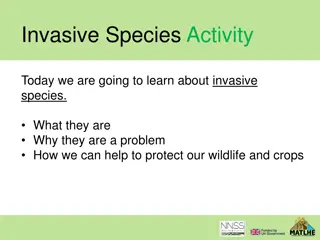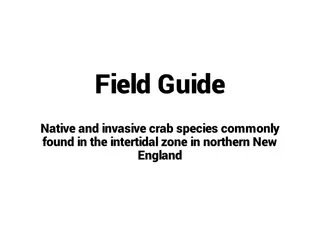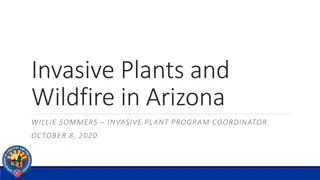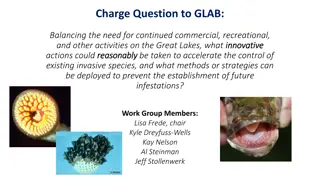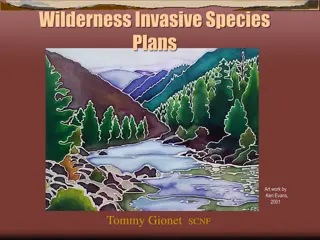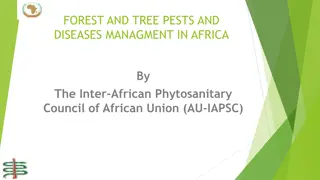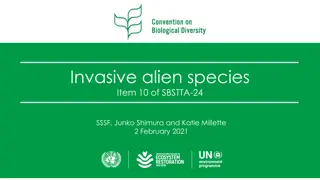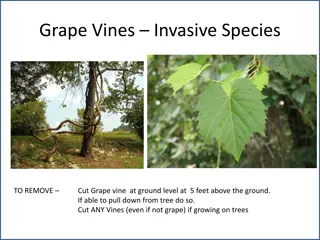Managing Invasive Species to Safeguard our Forests
Invasive species pose a significant threat to the health of our nation's forests and grasslands, causing ecological, biological, and economic losses. This presentation highlights the impact of invasive species and underscores the importance of collaborative efforts to effectively combat this problem. The National Strategy and Implementation Plan for Invasive Species Management lays out a science-based approach focusing on prioritization, collaboration, and accountability. Key elements include prevention, early detection, control, and rehabilitation to mitigate the harm caused by invasive species and ensure the sustainability of our forests for future generations.
Download Presentation

Please find below an Image/Link to download the presentation.
The content on the website is provided AS IS for your information and personal use only. It may not be sold, licensed, or shared on other websites without obtaining consent from the author. Download presentation by click this link. If you encounter any issues during the download, it is possible that the publisher has removed the file from their server.
E N D
Presentation Transcript
Invasive Species A Threat to the Health of the Nation s Forests and Grasslands Insert Name and Title of Presenter Here Insert Name of Event Here Caring for the land and serving people
Invasive Species Non-native species displace natives and cause ecological, biological, and economic losses. In 2002, invasives cost U.S. taxpayers $137 billion in damages. Most invasive species found in the U.S. were originally imported for food, fiber, or as ornamental plants.
Healthy Forests Make for a Healthy Nation The Forest Service is looking forward to its Next Century of Service, carrying on its mission of sustaining the health, diversity, and productivity of the Nation s forests and grasslands to meet the needs of present and future generations.
Invasive Species The leadership of the Forest Service determined that nothing short of a collaborative effort across deputy areas and in partnership with external organizations is required for an effective and proactive strategy against invasive species. This approach is spelled out in the National Strategy and Implementation Plan for Invasive Species Management.
Invasive Species Guiding Principles ofthe National Strategy 1. Science-based prioritization of invasive species problems. 2. Enhanced collaboration on the solutions to those problems. 3. An improved system of accountability that ensures the most efficient use of limited resources at all levels of the Forest Service.
Invasive Species Common Themes of the National Strategy Partnerships and Collaboration Scientific Basis Communication and Education Organizing for Success
Invasive Species Elements of the National Strategy 1. Prevention Keep out invasive species. 2. Early Detection and Rapid Response Detect and eradicate invasive species to stop them from spreading. 3. Control and Management Apply integrated control techniques to manage the problem. 4. Rehabilitation and Restoration Heal, minimize, or reverse the harmful effects from invasive species
Invasive Species Forest Service programs to fight invasives will focus on: Internally - stopping invasive species from becoming widespread in the National Forest system Externally supporting stewardship work on State, Tribal, and private partner lands
Invasive Species Distribution Maps of Invasive Species
Invasive Species Major Invasive Insects Asian longhorned beetle Hemlock woolly adelgid Emerald ash borer Gypsy moth
Invasive Species Diseases and pathogens Sudden Oak Death (SOD) canker White pine blister rust Port Orford cedar root disease
Invasive Species Plants (including aquatics and wetland) Leafy spurge Kudzu Saltcedar Mile-a-Minute
Invasive Species Plants (including aquatics and wetland) Purple loosestrife Yellow starthistle Spotted knapweed
Conclusion The National Strategy and Implementation Plan for Invasive Species Management is a significant milestone in the effort of the Forest Service to stem the tide of nonnative invasive species. A key to this effort is the two Environmental Threat Assessment Centers established in Prineville, Oregon and Asheville, North Carolina.





